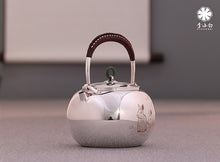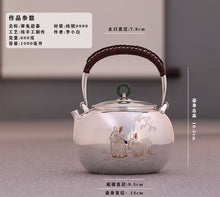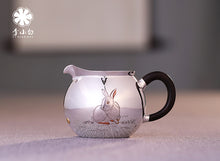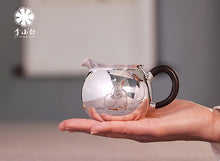
Pure silver is a beautiful white metal that shines like the moon. In Chinese characters, "silver" is often used to describe white and shiny things, such as the Milky Way, ginkgo, Tremella, silver screen, etc. The charm of silver has attracted Chinese and foreign enthusiasts since ancient times. Thousands of years ago, during the Tang and Song dynasties, silver tea sets led the trend in China at that time.
Lu Yu said in "The Classic of Tea" that boiling water with silver utensils is both clean and elegant. Except for being a little extravagant, there is nothing wrong with it. On the tea table, if there is a bright silver pot on the side, it can be a finishing touch, like a silver moon reflected between the mountains and rivers, bright but not ostentatious. Of course, the scene suitable for the silver pot does not necessarily have to be a tea table. It can also be a pleasing ornament when placed on a shelf.
Today, Tongxinshe Teahouse recommends the work of Mr. Li Fuming, the representative inheritor of Heqing silverware forging skills, a national intangible cultural heritage of China, and the founder of the famous silver pot design master "Li Xiaobai" Silver Pot Studio, "9999 Pure Silver Handmade Carved Rabbit Welcoming Spring Pure Silver Teapot/Gong Dao Bei/Kettle"
This silver pot has a capacity of 220 ml. It is based on the Wendan pot and adopts the decorative techniques of engraving, gold and copper inlay. A rabbit and cabbage are engraved on one side of the pot surface. The image is simple, but the craftsmanship is extremely sophisticated. The engraving of the overall image of the rabbit is completed by the engraving knife. The rabbit hair is particularly exquisite. The engraving of the rabbit hair must be carefully controlled according to the rabbit's body shape. Only in this way can the rabbit be vividly presented. The small cannon mouth has a refreshing water discharge, and the ring foot enhances the stability of the whole device. It can be said that this silver pot is modified and designed to meet the habits of current tea people.
Heqing, the capital of silverware in China, is an important town on the ancient Tea-Horse Road, with a long history of traditional ethnic handicrafts. "Look at Yunnan for Chinese silverware, and look at Heqing for Yunnan silverware." As early as the Nanzhao period, the small furnace makers there carried tools and walked through villages and alleys to make silver and copper wares. Generations of craftsmen have made Heqing's silver handicraft famous throughout the country with their hard work and sweat. The hardworking and wise Bai craftsmen have carved their skills in the world of Li Xiaobai's silver pot.
In 2008, Li Xiaobai's Silver Pot Studio was founded. With the handicraft production skills passed down from generation to generation for more than a thousand years, and absorbing traditional Chinese elements and modern elements, Li Xiaobai's Silver Pot has created its own independent style of handmade silverware. Li Xiaobai silver pot insists on pure handmade production, with a total of 18 processes: melting silver, opening slices, cutting, embryo 2 times, shaping, finalizing 4 times, shaping 4 times, grinding, polishing, wax injection, engraving, dewaxing, accessories production (pot stop, pot lid, pot handle, pot ears), grinding accessories, installation, secondary polishing, cleaning and water testing, and stamping. No quenching is done during the production process. Each process must wait for the product to cool naturally before the next process is carried out. The active silver ions are completely preserved, so when boiling water, it can not only purify the water quality, but also ensure the health of the body. At the same time, Li Xiaobai silver pot has no pores, and one pot can be used to brew a variety of teas. It will give full play to the tea fragrance of the tea, so that you and your family can drink a pot of pure and original tea.





















































